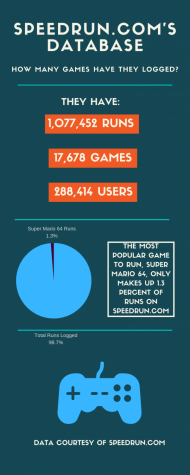What Makes Speedrunnning Interesting?
Speedrunning has become more popular as time has gone on, but what about speedrunning has made it more popular?
February 11, 2020
Speedrunning is usually defined as the act of playing a videogame as fast as possible to accomplish a certain goal, whether that be obtaining a certain item or

completing the game. Speedrunning has become much more mainstream and popular in recent years, with a greater variety of games and more runs logged online. Speedrun.com currently has a database of over 1 million runs of over 17,500 games by over 280,000 users. To say speedrunning is still a small, niche community is an understatement. So that begs the question: What makes speedrunning so interesting to watch?
Speedrunning’s Relevance to Mainstream Culture
Speedrunning is a phenomenon. Semiannually, the convention Games Done Quick (GDQ) is held in the United States (most recently held in Orlando, Florida). GDQ is a charity marathon convention, where speedrunners congregate and raise money through others attending the convention and donations acquired by those

watching live-streams of the convention at home. The most recent GDQ convention was from January 5th-12th, 2020, and it raised $3.1 million for the Prevent Cancer Foundation, with $25.6 million raised for various organizations across the 25 conventions.
The Guinness World Records recently partnered with Speedrun.com to “acknowledge some of the world’s most exceptional players,” according to an article published by Guinness World Records. Speedrunning is still considered a niche genre of entertainment and sport; however, this acknowledgment by a major governing body of world records notes a change in speedrunning as an activity that is specifically niche.
What kinds of speedrunning exist?
For as many games logged on Speedrun.com, there are almost infinite possibilities for the list of categories found for each game. The Legend of Zelda: Breath of the Wild (2017) has 27 categories, which include the additional category extensions. The extensions include (and are not limited to): “Die%” (where you kill Link as quickly as possible), “Dog%” (where you feed all of the dogs in Breath of the Wild and get the treasure they lead you to as fast as possible) and “Rake in Lake%” (which requires the player to place or throw a farming tool in any body of water with “lake” in its title). As evident by these miscellaneous categories in a single game, for as many speedrunners exist, there is an indefinite amount of types of speedruns.

Generally, the most popular category of almost any game is called “Any%”. This speedrun is simply the fastest completion of a game, usually with any means necessary. There are additional categories that ban the use of all glitches, or sometimes certain ones, but the gist is still the same. As with any category, speedrunners
devote hours upon hours of their lives to shave off time, sometimes only to save five or six seconds. One of the more popular “Any%” speedruns logged on Speedrun.com is Super Mario Odyssey (2017), which has over 1700 “Any%” runs. If the sheer volume is any indication, “Any%” is a popular category.
Symmetry is natural in the world, and due to the existence of “Any%” speedruns, its opposite pf “100%” speedruns also exists. Just as the name implies, “100%” speedruns require the runner to collect all items and achievements. These runs are usually much longer than “Any%” speedruns, with some runs going for several days. For example, where Breath of the Wild’s “Any%” world record clocks in at 27 minutes, 29 seconds, and 530 milliseconds, the “100%” world record clocks in at just over 21 hours.
“Memeruns”, or meme speedruns, is another popular category of speedruns. This is more of a general category that encompasses a wide variety of runs. The aforementioned “Rake in Lake%” qualifies as a memerun, as does “Death%”. A classic, and more uncommon, memerun is “10 Pencils Drillless%” underneath the “In Real Life%” category of Pencil Sharpening Simulator (2015), and the goal of this memerun is simple: sharpen 10 pencils as fast as possible, by hand. Another memerun is with the game Cookie Clicker, and this run includes getting to one billion cookies without using any upgrades at all. Unsurprisingly, the world record clocks in at 6 hours, 7 minutes, and 40 seconds.
Speedruns don’t just include video games—they extend to real life (otherwise known as IRL, or “in real life” speedruns). A common example of an IRL speedrun is with the Rubix Cube. Speedrunning is not only sequestered to video games but includes some real-life puzzles.
What makes speedrunning interesting to watch?
Speedrunning frequently features mesmerizing tricks and clips, world records that some players consider impossible to attain, and some incredibly entertaining and alluring individuals to watch. There is a variety of reasons someone may watch speedruns, and in the case of Lynn Slutsky, a senior at Mendham High School, she enjoys watching speedruns for a variety of reasons.
She has consistently watched speedruns for “about less than a year,” but she’s “been interested in them for a while.” Slutsky mainly watched speedruns from the game Super Mario Odyssey, but generally watches the various streams GDQ posts on their YouTube channel. From her various viewings, Slutsky finds “how much time and effort people put into pretty much useless tasks.” This monotony is attractive to a large portion of viewers, considering that speedruns don’t amount to much outside of the speedrunning communities. The adrenaline and joy present in a speedrunner is evident when hundreds of hours in a game result in a new personal best or even a world record.
People also enjoy watching speedruns for more personal reasons. Slutsky has a personal interest in computer science, and she stated that “it is engaging for me to see the inner workings of a code-based video game, giving insight into how the programmers made it and then how people discovered it in order to exploit their code to complete the game.” These personal reasons extend to the entirety of the speedrunning community. Everyone has their own reasons for watching speedruns, whether it be that the code exploitation is fascinating, or that continually watching speedruns provides someone with a close community (possibly even friends) to connect with. Due to Slutsky’s personal interest in computer science, she cites that “credit warps and arbitrary code execution” as very interesting to her.
These tricks are another reason people enjoy watching speedruns. The manners in which speedrunners manipulate the games they play is mesmerizing. The Legend of Zelda: Ocarina of Time (1998) “Any%” world record runner Lozoots has a series of movements that demonstrate his skill, as he frequently hops backward while making out-of-bounds clips without a view of his character on screen. His movement is smooth, and when it comes to a glitch that warps him from the beginning area to the end credits of the game, his clean and rapid movement glues the watcher’s eyes to the screen. His world record clocks in at 9:57.02.
People flock to speedruns for a variety of reasons, and there will be many more that cause new people to watch them. As speedrunning continues to become more popular in mainstream media, only time will tell how large the speedrunning community will become.
